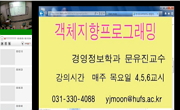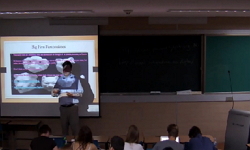프로덕트 라인 공학(Product Line Engineering, PLE)은 소프트웨어 재사용을 위한 새로운 접근 방법이고, 핵심자산은 인스턴시에이션(Instantiation)을 통하여 어플리케이션을 개발하기 위한 큰 재사용 ...
http://chineseinput.net/에서 pinyin(병음)방식으로 중국어를 변환할 수 있습니다.
변환된 중국어를 복사하여 사용하시면 됩니다.
- 中文 을 입력하시려면 zhongwen을 입력하시고 space를누르시면됩니다.
- 北京 을 입력하시려면 beijing을 입력하시고 space를 누르시면 됩니다.

프로덕트 라인 공학의 핵심자산 재사용성 평가를 위한 품질시스템 = A Quality System for Evaluating Reusability of Core Assets in Product Line Engineering
한글로보기https://www.riss.kr/link?id=A82293674
- 저자
- 발행기관
- 학술지명
- 권호사항
-
발행연도
2006
-
작성언어
Korean
-
주제어
프로덕트 라인 ; 재사용성 ; 품질시스템 ; 품질속성 ; 메트릭 ; Product Line ; Reusability ; Quality System ; Quality Attribute ; Metric
-
KDC
569
-
등재정보
KCI등재
-
자료형태
학술저널
-
수록면
277-288(12쪽)
-
KCI 피인용횟수
1
- 제공처
- 소장기관
-
0
상세조회 -
0
다운로드
부가정보
국문 초록 (Abstract)
프로덕트 라인 공학(Product Line Engineering, PLE)은 소프트웨어 재사용을 위한 새로운 접근 방법이고, 핵심자산은 인스턴시에이션(Instantiation)을 통하여 어플리케이션을 개발하기 위한 큰 재사용 단위이다. 따라서, 핵심자산은 PLE의 중요한 요소이므로 핵심자산의 재사용성은 PLE 프로젝트의 큰 성공을 결정한다. 핵심자산은 전체가 아니라 재사용 부품(Part)에 불과하며, 고정된 기능뿐만 아니라 가변적인 기능도 포함, 지원하고 있다. 그러나, 기존의 품질모델로는 이러한 특성을 가지고 있는 핵심자산을 평가하기에는 한계가 있다. 따라서, 본 논문에서는 이러한 문제점을 해결하기 위해 ISO/IEC 9126을 기반으로 하여 핵심자산의 재사용성을 평가하기 위한 체계적인 품질시스템을 제안한다. 핵심자산의 중요한 특징들을 식별하고 식별된 재사용성의 특징을 기반으로 품질속성(Quality Attribute)을 도출한다. 이렇게 정의된 품질속성을 이용하여 메트릭을 정의한다. 또한 제안된 메트릭을 이용하기 위한 지침 및 대여 프로덕트 라인에서의 적용사례를 제시한다. 이러한 품질시스템을 이용하여 핵심자산의 재사용성을 보다 효과적이고 정확하게 평가한다.
다국어 초록 (Multilingual Abstract)
Product line engineering (PLE) is a new effective approach to software reuse, where applications are generated by instantiating a core asset which is a large-grained reuse unit. Hence, a core asset is a key element of PLE, and therefore the reusabilit...
Product line engineering (PLE) is a new effective approach to software reuse, where applications are generated by instantiating a core asset which is a large-grained reuse unit. Hence, a core asset is a key element of PLE, and therefore the reusability of the core asset largely determines the success of PLE projects. A core asset is a reusable part not a whole system, and supports not only variable functions but also common functions. However, there are limitations to evaluate reusability of core asset that has these unique characteristics. This paper proposes a comprehensive quality system for evaluating the reusability of core assets, based on ISO/IEC 9126. We first identify the key characteristics of core assets, and derive the set of quality attributes that characterizes the reusability of core assets. Finally, we define metrics for each quality attribute. In addition, we provide guidelines for applying the metrics and perform a case study based on rental product line. Using the proposed quality system, reusability of core assets can be more effectively and correctly evaluated.
목차 (Table of Contents)
- 요약
- Abstract
- 1. 서론
- 2. 관련연구
- 3. 기반연구
- 요약
- Abstract
- 1. 서론
- 2. 관련연구
- 3. 기반연구
- 4. 핵심자산의 특징
- 5. 재사용성 평가를 위한 품질속성
- 6. 재사용성을 평가하기 위한 메트릭
- 7. 사례연구
- 8. 결론
- 참고문헌
- 저자소개
참고문헌 (Reference)
1 "Variability Design and Customization Mechanisms for COTS Components" LNCS 3480 : 57-66, 2005.
2 "Traceability Map : Foundations to Automate for Product Line Engineering" 2005
3 "Software Product Lines" Addison-Wesley 2002.
4 "Software Engineering-Product Quality-Part 3: Internal Metrics" 2003.
5 "Software Engineering-Product Quality-Part 1: Quality Model" 2001.
6 "Software Architecture in Practice" Addison-Wesley 2003.
7 "Quality-driven architecture design and quality analysis method: A revolutionary initiation approach to a product line architecture" 2002
8 "PuLSE: A Methodology to Develop Software Product Lines" 1999
9 "Measures for Software Product Lines" 2003
10 "From problem to solution with quality attributes and design aspects" 66 : 199-211, 2003.
1 "Variability Design and Customization Mechanisms for COTS Components" LNCS 3480 : 57-66, 2005.
2 "Traceability Map : Foundations to Automate for Product Line Engineering" 2005
3 "Software Product Lines" Addison-Wesley 2002.
4 "Software Engineering-Product Quality-Part 3: Internal Metrics" 2003.
5 "Software Engineering-Product Quality-Part 1: Quality Model" 2001.
6 "Software Architecture in Practice" Addison-Wesley 2003.
7 "Quality-driven architecture design and quality analysis method: A revolutionary initiation approach to a product line architecture" 2002
8 "PuLSE: A Methodology to Develop Software Product Lines" 1999
9 "Measures for Software Product Lines" 2003
10 "From problem to solution with quality attributes and design aspects" 66 : 199-211, 2003.
11 "Design and Use of Software Architectures" Addison-Wesley 2000.
12 "DREAM : A Practical Product Line Engineering using Model Driven Architecture" 1 : 70-75, 2005
13 "Component Metrics to Measure Component Quality" 419-426, 2001.
14 "C-QM : A Practical Quality Model for Evaluating COTS Components" 2003.
15 "A Theoretical Foundation of Variability in Component-Based Development" 47 : 663-673, 2005.
16 "A Systematic Process to Design Product Line Architecture" 46-56, 2005.
17 "A Systematic Methodology for Developing Component Frameworks" 359-373, 2004.
18 "A Systematic Method to Instantiate Core Assets in Product Line Engineering" 92-98, 2004.
19 "A Systematic Method to Identify Software Components" 538-545, 2004.
20 "A Metrics Suite for Measuring Reusability of Software Components" 211-223, 2003.09
21 "A Framework for Product Line Quality Model Development : The PuLSE-Eco Meta Quality Model" 2001.
동일학술지(권/호) 다른 논문
-
기업 고유환경기반 실제구현을 위한 소프트웨어 프로세스 개선모델 확장
- 한국정보과학회
- 김강태(Kangtae Kim)
- 2006
- KCI등재
-
제품 라인에서 컴포넌트 구조를 활용한 컴포넌트 스펙 방법
- 한국정보과학회
- 조혜경(Hye-Kyung Cho)
- 2006
- KCI등재
-
컴포넌트 기반 시스템에서 클래스들 간의 정적 그리고 동적 특성을 적용한 컴포넌트 메트릭스
- 한국정보과학회
- 최미숙(Misook Choi)
- 2006
- KCI등재
-
자기적응형 소프트웨어를 위한 목표 기반의 외부상황 평가 기법
- 한국정보과학회
- 김재선(Jae Sun Kim)
- 2006
- KCI등재
분석정보
인용정보 인용지수 설명보기
학술지 이력
| 연월일 | 이력구분 | 이력상세 | 등재구분 |
|---|---|---|---|
| 2014-09-01 | 평가 | 학술지 통합(기타) | |
| 2013-04-26 | 학술지명변경 | 한글명 : 정보과학회논문지 : 소프트웨어 및 응용</br>외국어명 : Journal of KIISE : Software and Applications |  |
| 2011-01-01 | 평가 | 등재학술지 유지(등재유지) |  |
| 2009-01-01 | 평가 | 등재학술지 유지(등재유지) |  |
| 2008-10-17 | 학술지명변경 | 한글명 : 정보과학회논문지 : 소프트웨어 및 응용</br>외국어명 : Journal of KISS : Software and Applications |  |
| 2007-01-01 | 평가 | 등재학술지 유지(등재유지) |  |
| 2005-01-01 | 평가 | 등재학술지 유지(등재유지) |  |
| 2002-01-01 | 평가 | 등재학술지 선정(등재후보2차) |  |




 ScienceON
ScienceON DBpia
DBpia





